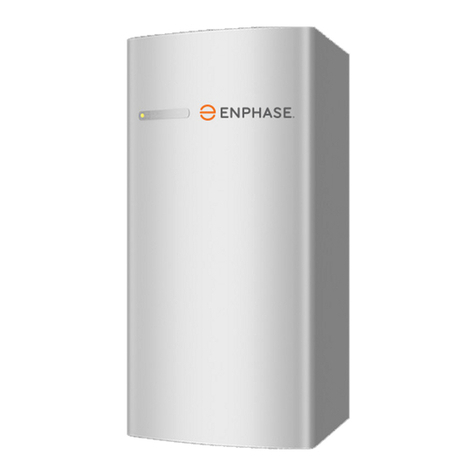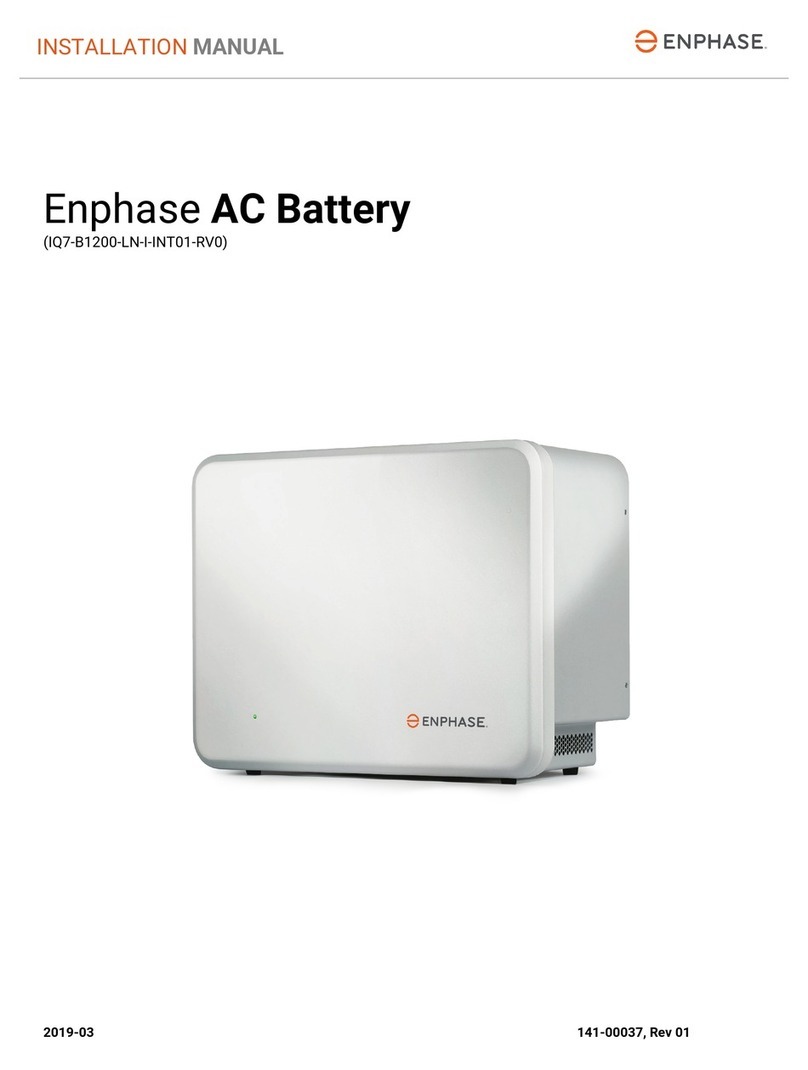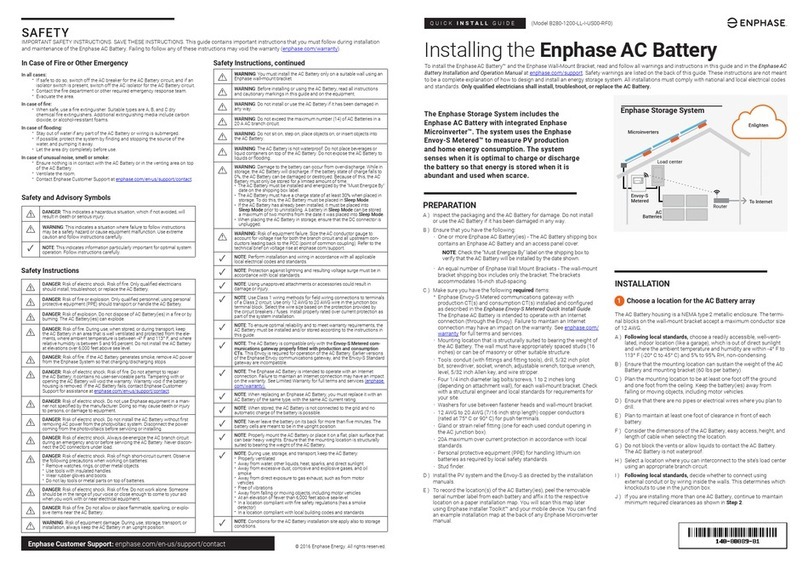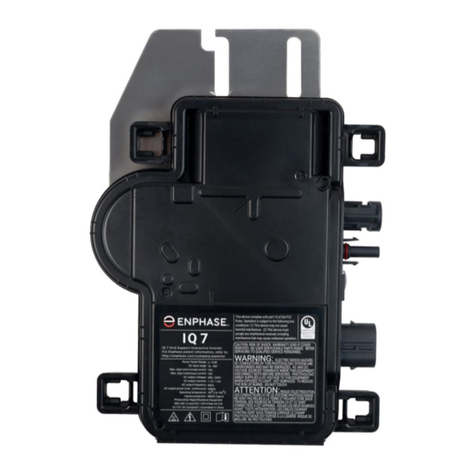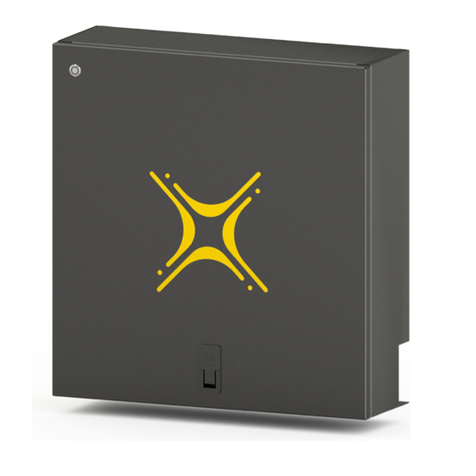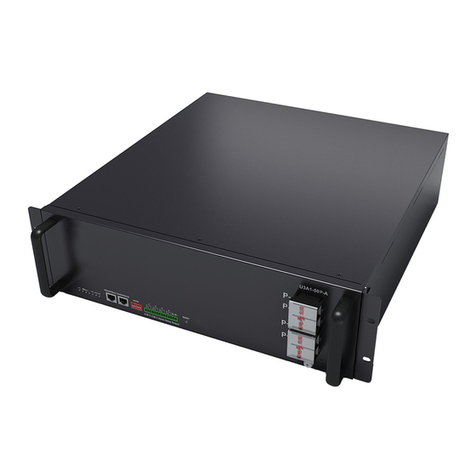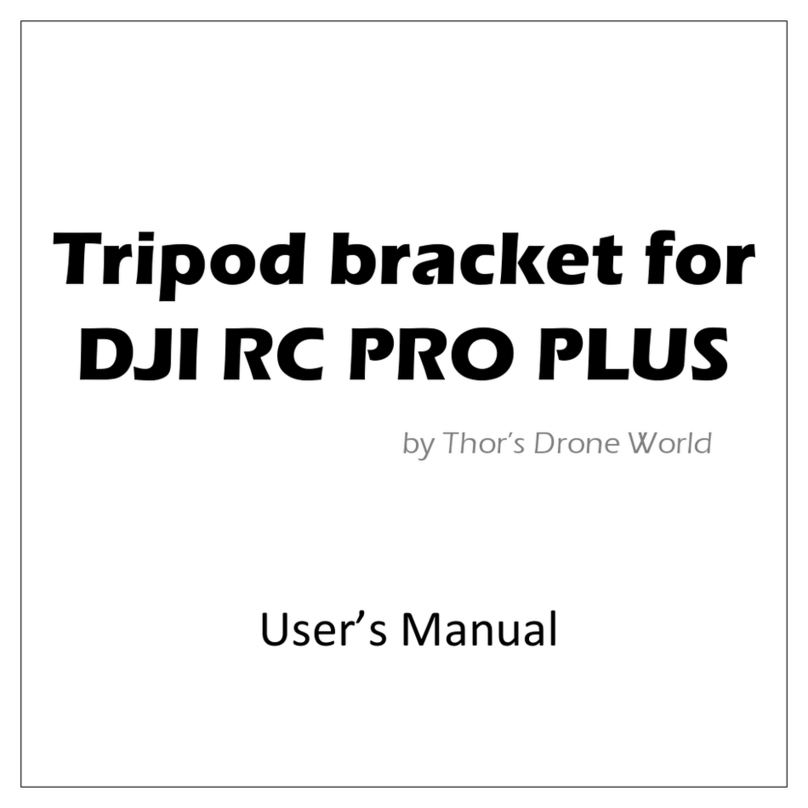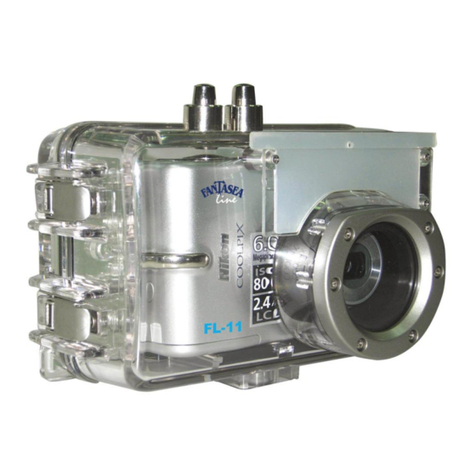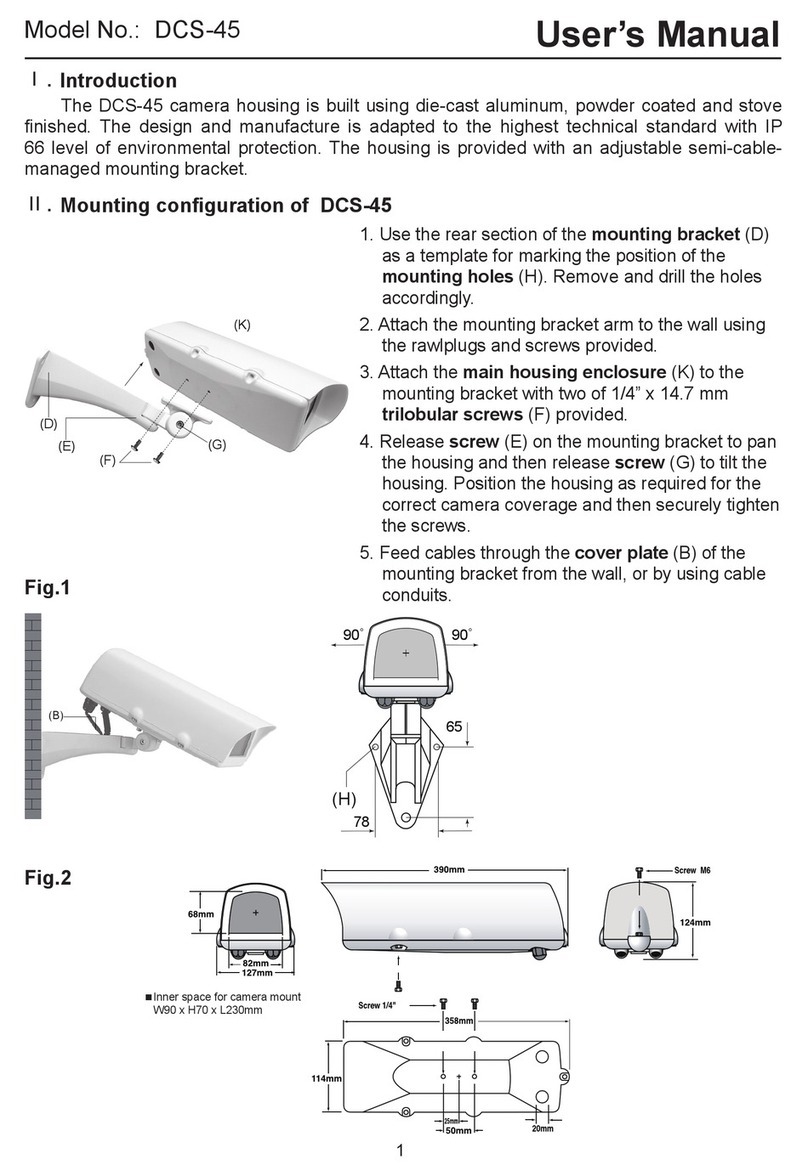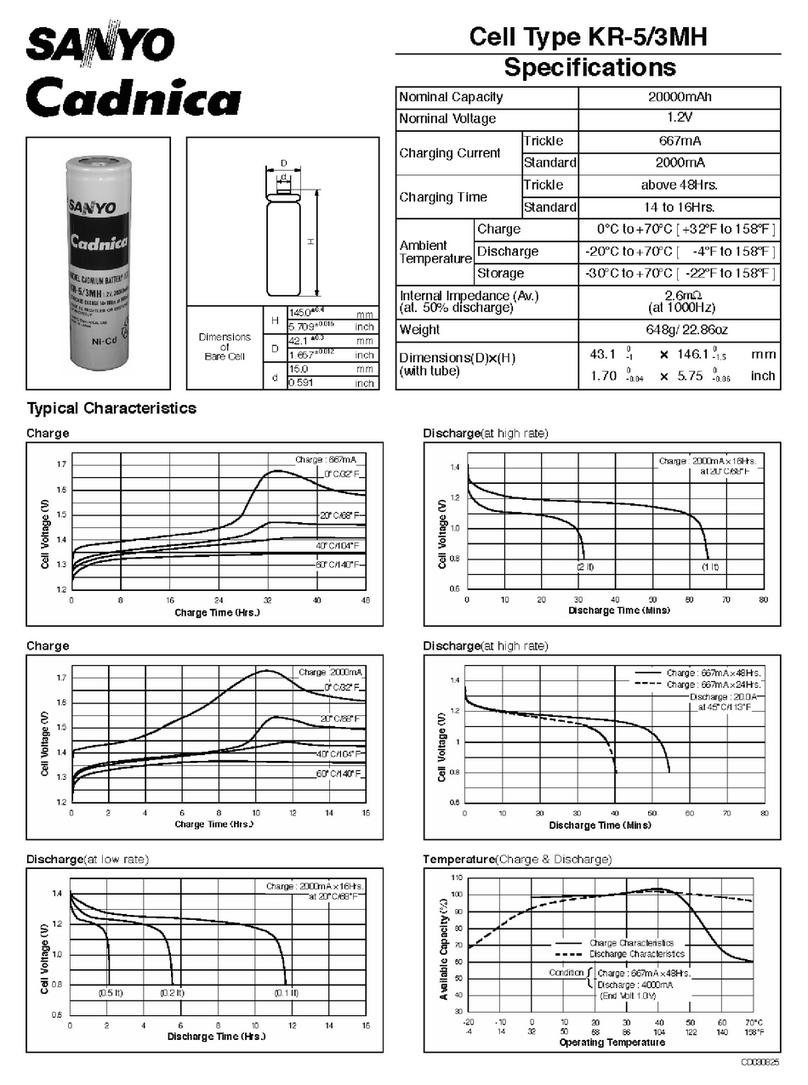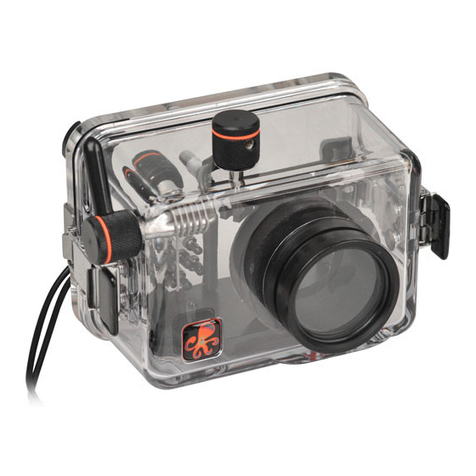enphase B270-1200-LN-I-EU00-RV0 User manual

QUICK INSTALL GUIDE (Model B270-1200-LN-I-EU00-RV0)
Installing the Enphase AC Battery
To install the EnphaseAC Battery™ and the Enphase Wall-Mount Bracket, read and follow all warnings and instructions in this guide and in the Enphase AC
Battery Installation and Operation Manual at enphase.com/support. Safety warnings are listed on the back of this guide. These instructions are not meant
to be a complete explanation of how to design and install an energy storage system. All installations must comply with national and local electrical codes
and standards. Only qualied electricians shall install, troubleshoot, or replace the AC Battery.
The Enphase Storage System includes the
Enphase AC Battery with integrated Enphase
Microinverter™. The system uses the Enphase
Envoy-S Metered™ to measure PV production and
home energy consumption. The system knows
when it is optimal to charge or discharge battery
power so that energy is stored when it is abundant
and used when scarce.
Enphase Customer Support: enphase.com/global/support/contact
Safety and Advisory Symbols
+DANGER: This indicates a hazardous situation, which if not avoided, will
result in death or serious injury.
*WARNING: This indicates a situation where failure to follow instructions
may be a safety hazard or cause equipment malfunction. Use extreme
caution and follow instructions carefully.
✓NOTE: This indicates information particularly important for optimal system
operation. Follow instructions carefully.
Safety Instructions
+DANGER: Risk of electric shock. Risk of re. Only qualied electricians
should install, troubleshoot, or replace the AC Battery.
+DANGER: Risk of re or explosion. Only qualied personnel, using personal
protective equipment (PPE) should transport or handle the AC Battery.
+DANGER: Risk of explosion. Do not dispose of AC Battery(ies) in a re or by
burning. The AC Battery(ies) can explode.
+DANGER: Risk of re. During use, when stored, or during transport, keep
the AC Battery in an area that is well ventilated and protected from the
elements, where ambient temperature is between -20° C and 45° C, and
where relative humidity is between 5 and 95 percent.
+DANGER: Risk of re. If the AC Battery generates smoke, remove AC power
from the Enphase System so that charging/discharging stops.
+DANGER: Risk of electric shock. Risk of re. Do not attempt to repair
the AC Battery; it contains no user-serviceable parts. Tampering with or
opening the AC Battery will void the warranty. Warranty void if the battery
housing is removed. If the AC Battery fails, contact Enphase Customer
Support for assistance at enphase.com/global/support/contact.
+DANGER: Risk of electric shock. Do not use Enphase equipment in a man-
ner not specied by the manufacturer. Doing so may cause death or injury
to persons, or damage to equipment.
+DANGER: Risk of electric shock. Do not install the AC Battery without rst
removing AC power from the photovoltaic system. Disconnect the power
coming from the photovoltaics before servicing or installing.
+DANGER: Risk of electric shock. Always de-energise the AC branch circuit
during an emergency and/or before servicing the AC Battery. Never discon-
nect the DC connectors under load.
+DANGER: Risk of electric shock. Risk of high short-circuit current. Observe
the following precautions when working on batteries:
• Remove watches, rings, or other metal objects.
• Use tools with insulated handles.
• Wear rubber gloves and boots.
• Do not lay tools or metal parts on top of batteries.
+DANGER: Risk of electric shock. Risk of re. Do not work alone. Someone
should be in the range of your voice or close enough to come to your aid
when you work with or near electrical equipment.
+DANGER: Risk of re. Do not allow or place ammable, sparking, or explo-
sive items near the AC Battery.
*WARNING: Risk of equipment damage. During use, storage, transport, or
installation, always keep the AC Battery in an upright position.
*WARNING: You must install the AC Battery only on a suitable wall using an
Enphase wall-mount bracket.
*WARNING: Before installing or using the AC Battery, read all instructions
and cautionary markings in this guide and on the equipment.
*WARNING: Do not install or use the AC Battery if it has been damaged in
any way.
*WARNING: Do not exceed the maximum number (13) of AC Batteries in a
20A AC branch circuit.
*WARNING: Do not sit on, step on, place objects on, or insert objects into
the AC Battery.
*WARNING: The AC Battery is not waterproof. Do not place beverages or
liquid containers on top of the AC Battery. Do not expose the AC Battery to
liquids or ooding.
*WARNING: Damage to the battery can occur from over-discharge. While in
storage, the AC Battery will discharge. If the battery state of charge falls to
0%, the AC Battery can be damaged or destroyed. Because of this, the AC
Battery must only be stored for a limited amount of time.
• The AC Battery must be installed and energised by the “Must Energize By”
date on the shipping box label.
• The AC Battery must have a charge state of at least 30% when placed in
storage.
• If the AC Battery has already been installed, it must be placed into
Sleep Mode prior to uninstalling. A battery in Sleep Mode can be stored
a maximum of two months from the date it was placed into Sleep Mode.
• When placing the AC Battery in storage, ensure that the DC connector is
unplugged.
*WARNING: Risk of equipment failure. Size the AC conductor gauge to
account for voltage rise for both the branch circuit and all upstream con-
ductors leading back to the point of connection. Refer to the technical brief
on voltage rise at enphase.com/support.
✓NOTE: Perform installation and wiring in accordance with all applicable
local electrical codes and standards.
✓NOTE: Protection against lightning and resulting voltage surge must be in
accordance with local standards.
✓NOTE: Using unapproved attachments or accessories could result in
damage or injury.
✓NOTE: Use Class 1 wiring methods for eld wiring connections to terminals
of a Class 2 circuit. Use only 2.5 mm2to 4 mm2 wire in the junction box
terminal block. Select the wire size based on the protection provided by
the circuit breakers / fuses. Install properly rated over current protection as
part of the system installation.
✓NOTE: To ensure optimal reliability and to meet warranty requirements, the
AC Battery must be installed and/or stored according to the instructions in
this guide.
✓NOTE: The AC Battery is compatible only with the Envoy-S Metered com-
munications gateway properly tted with production and consumption
CTs. This Envoy is required for operation of the AC Battery. Earlier versions
of the Enphase Envoy communications gateway, and the Envoy-S Standard
gateway are incompatible.
✓NOTE: The Enphase AC Battery is intended to operate with an Internet
connection. Failure to maintain an Internet connection may have an impact
on the warranty. See Limited Warranty for full terms and services (enphase.
com/warranty).
✓NOTE: When replacing an Enphase AC Battery, you must replace it with an
AC Battery of the same type, with the same AC current rating.
✓NOTE: When stored, the AC Battery is not connected to the grid and no
automatic charge of the battery is possible.
✓NOTE: Never leave the battery on its back for more than ve minutes. The
battery cells are meant to be in the upright position.
✓NOTE: Properly mount the AC Battery or place it on a at, plain surface that
can bear heavy weights. Ensure that the mounting location is structurally
suited to bearing the weight of the AC Battery.
✓NOTE: During use, storage, and transport, keep the AC Battery:
• Properly ventilated
• Away from water, other liquids, heat, sparks, and direct sunlight
• Away from excessive dust, corrosive and explosive gases, and oil
smoke
• Away from direct exposure to gas exhaust, such as from motor
vehicles
• Free of vibrations
• Away from falling or moving objects, including motor vehicles
• At an elevation of fewer than 2,000m above sea-level
• In a location compliant with re safety regulations (has a smoke
detector)
• In a location compliant with local building codes and standards
✓NOTE: Conditions for the AC Battery installation site apply also to storage
conditions.
SAFETY
IMPORTANT SAFETY INSTRUCTIONS. SAVE THESE INSTRUCTIONS. This guide contains important instructions that you must follow during installation
and maintenance of the Enphase AC Battery. Failing to follow any of these instructions may void the warranty (enphase.com/warranty).
In Case of Fire or Other Emergency
In all cases:
• If safe to do so, switch off the AC breaker for the AC Battery circuit, and if an
isolator switch is present, switch off the AC isolator for the AC Battery circuit.
• Contact the re department or other required emergency response team.
• Evacuate the area.
In case of re:
• When safe, use a re extinguisher. Suitable types are A, B, and C dry
chemical re extinguishers. Additional extinguishing media include carbon
dioxide, or alcohol-resistant foams.
In case of ooding:
• Stay out of water if any part of the AC Battery or wiring is submerged.
• If possible, protect the system by nding and stopping the source of the
water, and pumping it away.
• Let the area dry completely before use.
In case of unusual noise, smell or smoke:
• Ensure nothing is in contact with the AC Battery or in the venting area on top
of the AC Battery.
• Ventilate the room.
• Contact Enphase Customer Support at enphase.com/global/support/contact.
Safety Instructions, continued
© 2016 Enphase Energy. All rights reserved.
Enphase Storage System
Microinverters
Envoy-S
Metered
Switchboard
Router
Enlighten
To Internet
AC
Batteries
INSTALLATION
Choose a location for the AC Battery array
The AC Battery housing is an IP-20 rated metallic enclosure. The termi-
nal blocks on the wall-mount bracket accept a maximum conductor size
of 4 mm2.
A ) Following local standards, choose a readily accessible, well-venti-
lated, indoor location (like a garage), which is out of direct sunlight
and where the ambient temperature and humidity are within -20° C
to 45° C and 5% to 95% RH, non-condensing.
B ) Ensure that the mounting location can sustain the weight of the AC
Battery and mounting bracket (28 kg or 60 lbs per battery).
C ) Plan the mounting location to be at least 300 mm (one foot) off
the ground and 300 mm (one foot) from the ceiling. Keep the
battery(ies) away from falling or moving objects, including motor
vehicles.
D ) Ensure that there are no pipes or electrical wires where you plan to
drill.
E ) Plan to maintain at least 300 mm (one foot) of clearance in front of
each battery.
F ) Consider the dimensions of the AC Battery, easy access, height, and
length of cable when selecting the location.
G ) Do not block the vents or allow liquids to contact the AC Battery.
The AC Battery is not waterproof.
H ) Select a location where you can connect to the site’s switchboard
(load centre) using an appropriate branch circuit.
I ) Following local standards, decide whether to connect using
external conduit or by wiring inside the walls. This determines which
knockouts to use in the junction box. Check if an AC isolator is
needed. Plan the location for the AC isolation switch, if needed.
J ) If you are installing more than one AC Battery, continue to maintain
minimum required clearances as shown in Step 2.
1
PREPARATION
A ) Inspect the packaging and the AC Battery for damage. Do not install
or use the AC Battery if it has been damaged in any way.
B ) Ensure that you have 1) one or more Enphase AC Battery(ies) and
2) an equal number of Enphase Wall-Mount Brackets:
• The AC Battery shipping box contains an Enphase AC Battery and
an access panel cover.
NOTE: Check the “Must Energize By” label on the shipping box to
verify that the AC Battery will be installed by the date shown.
• The wall-mount bracket shipping box includes only the bracket.
Brackets are available in two widths to accommodate 450 mm and
600 mm stud-spacing.
C ) Make sure you have the following required items:
• Enphase Envoy-S Metered communications gateway with
production CT(s) and consumption CT(s) installed and congured
as described in the Enphase Envoy-S Metered Quick Install Guide.
The Enphase AC Battery requires an Internet connection (through
the Envoy). Failure to maintain an Internet connection may have an
impact on the warranty. See enphase.com/warranty for full terms
and services.
• Mounting location that is structurally suited to bearing the weight of
the AC Battery. The wall must have appropriately spaced studs (450
mm or 600 mm) or can be a masonry wall.
• Tools: conduit (with ttings and tting tools), drill, 4 mm pilot bit,
screwdriver, socket, spanner, adjustable spanner, torque wrench,
level, 4 mm Allen key, and wire stripper.
• Four 6 mm diameter lag bolts/screws, 25 to 50 mm long (depending
on attachment wall), for each wall-mount bracket. Check with a
structural engineer and local standards for requirements for your
site.
• Washers for use between fastener heads and wall-mount bracket.
• 2.5 mm2to 4 mm2 (11 mm strip length) copper conductors (rated at
75° C or 90° C) for push terminals.
• Gland or strain relief tting (one for each used conduit opening in
the AC junction box).
• 20A maximum over current protection in accordance with local
standards.
• Personal protection equipment (PPE) for handling lithium ion
batteries as required by local safety standards.
D ) Make sure you have the following optional items, if needed:
• 20A maximum AC isolator
• Stud nder
E ) Install the PV system and the Envoy-S as directed by the installation
manuals.
F ) To record the location(s) of the AC Battery(ies), peel the removable
serial number label from each battery and afx it to the respective
location on a paper installation map. You will scan this map later
using Enphase Installer Toolkit™ and your mobile device. You can nd
an example installation map at the back of any Enphase Microinverter
manual.

Install the AC isolator, if required
Following all local codes and standards:
A ) Choose an AC Isolator that can break the maximum rated current of
the branch circuit under load (20 A maximum).
B ) Connect one side of the isolator to the switchboard (load centre).
C ) Verify that AC voltage at the site is within range: single-phase L1 to N
measures 200-270 VAC.
* WARNING! Risk of equipment failure. Size the AC conductor
gauge to account for voltage rise for both the branch circuit and all
upstream conductors leading back to the point of connection. Refer
to the technical brief on voltage rise at enphase.com/support.
3
Install the wall-mount bracket
A ) Make sure that the wall-mount bracket matches the wall stud spacing
and that the lowest wall-mount bracket position meets clearance
requirements as shown.
(Dimensions shown are for the 450 mm wall-mount bracket. See the
image below for the 600 mm bracket.)
* WARNING! Risk of injury and equipment damage. Protect the AC
Battery from impact damage and improper use.
B ) Remove the appropriate knockout(s) for the planned entry into the
wall-mount bracket junction box:
• If wiring inside the walls, use the knockout(s) in the back of each
junction box. If using conduit, use the knockouts at the bottom of
the junction box.
• If installing only one battery, use only one knockout.
• Loosen the screw securing the junction box cover and remove the
cover. Keep the cover handy as you will need it later.
C ) Starting at battery position closest to the power source, mark a level
line on the wall as a guide.
* WARNING! Multiple risks. Make sure not to drill or attach into
electric wiring or pipes that are in the wall!
2
D ) Place the wall-mount bracket on the wall so that the mark on the
bracket aligns with the centre of the stud. Use a level to keep the
top of the wall-mount bracket at, and attach each corner of the
wall-mount bracket using one screw and washer for each slot.
E ) Verify that the wall-mount bracket is solidly attached to the wall.
* WARNING! Risk of injury and equipment damage. Do not mount
an AC Battery on a bracket that is not properly mounted.
F ) If installing additional batteries, install the adjacent wall-mount brack-
ets in an interleaved fashion, as needed. Be sure to align the mark on
the adjacent wall-mount bracket to the centre of the wall stud. A small
gap in between the adjacent wall-mount brackets is normal. You may
install another row of wall-mount brackets above the one already
installed. Maintain at least 300 mm (one foot) clearance between
rows.
Dimension for the 600 mm wall-mount bracket:
Wire the junction box
A ) Size the conductors (Line, Neutral and Earth) depending on the up-
stream breaker or fuse. Use 2.5 mm2- 4 mm2wire with maximum
20A branch circuit protection.
+ DANGER! Risk of electric shock. Check that the dedicated
circuit breaker protecting the branch where the AC Battery will be
connected is turned off before wiring.
* WARNING! Risk of equipment damage. Never connect an
Enphase AC Battery junction box to two active conductors. Always
connect to one Line (active) and one Neutral.
B ) Using the conductors and suitable conduits, connect the AC
isolator (if used) and the rst adjacent AC Battery junction box. Use
the openings provided by the knockouts to connect the conduits
and pass the wires through them.
NOTE: Do not modify or rewire the pre-installed wiring or bonding
connections in the junction box.
C ) Connect each wire in the junction box to its corresponding conduc-
tor (Line, Neutral and Earth). Each push terminal accepts two 2.5
mm2- 4 mm2conductors (11 mm strip length). Use a screw driver
to depress the terminal.
D ) After all wires in the junction box are connected and secured, check
that there are no exposed conductors.
E ) If connecting additional AC Batteries, be sure to use another
conduit and another set of wires to connect between junction
boxes.
F ) Gently arrange all the wires and connectors inside the junction
box and replace the cover. Tighten the cover screw using a Phillips
screw driver.
+ DANGER! Risk of electric shock. The system is not ready to
be energised! Do not close the circuit breaker yet.
4
Mounting
slots
Junction box
Junction box
cover screw
300 mm
(minimum)
spacing Wall-mount brackets
shown interleaved
Mounting
slots
300 mm minimum
height from ground
300 mm minimum
from ceiling
Earth from this
junction box, from
chassis screw
Terminal block Earth from AC
isolator or previous
junction box
Line from AC isolator
or previous junction
box
Neutral
Line from this
junction box, from
connector
Neutral
Junction box detail
Neutral to next
junction box, if
needed
Line to next junction
box, if needed
Earth to next
junction box, if
needed
Junction box
AC connector
Energise the system
*WARNING: Before energizing, make sure that ALL batteries
in the system are properly installed and conductors terminated.
A ) Check that the AC Battery bottom access is plate is closed and
secured.
B ) Turn on the circuit feeding the AC Battery(ies).
C ) The AC Battery LED should now be solid red for the duration of
the startup process. If the LED is not solid red, see the following
section on Troubleshooting.
6
Use the Enphase Installer Toolkit to commission the AC Battery(ies).
You can access help topics once you connect Installer Toolkit to the
Envoy.
After the Envoy-S has detected the AC Battery(ies), the AC Battery
LEDs operate as described in the following section.
CONFIGURE and ACTIVATE
OPERATION
aLED overview
The LED lights red while the AC Battery boots up. If the LED remains
red for more than two minutes, the battery is in trickle charge mode
and will remain so until it reaches a minimum state of charge (up to
30 minutes). After the AC Battery is booted up, the LED becomes blue
or green (depending on the charge level). If the LED remains red after
one hour or changes to a ashing red state, contact Enphase Custom-
er Support at enphase.com/global/support/contact.
State Description
Solid red Starting up
Red ashes in sequences of 2 Error. See “Troubleshooting”.
Solid amber Not operating due to high temperature. See
“Troubleshooting”.
Solid blue or green Idle - color transitions from blue to green as
state of charge increases. You can check
Enlighten for charge status.
Slowly ashing blue Discharging
Slowly ashing green Charging
Green one second ashing Looking for noncommissioned unit
Off Not operating. See “Troubleshooting”.
bTroubleshooting
If the AC Battery is not operating correctly, perform the following
steps. If the issue persists, contact Enphase Customer Support at
enphase.com/global/support/contact.
A ) If the AC Battery does not operate, check the temperature in the
room and increase cooling and/or ventilation as required. Check
that the front, top, and sides of the AC Battery array have at least
300 mm of unobstructed clearance.
B ) If the AC Battery LED is off, turn off the breaker for the branch
circuit, wait for at least one minute, and turn it back on.
NOTE: During a brownout or blackout, the AC Battery powers
down automatically. This is normal. When power is restored, it
automatically starts up again.
C ) If you do not see AC Battery information in Enlighten, check that
the Envoy-S and the Internet connection are working.
D ) Refer to the AC Battery Installation and Operation Manual at
enphase.com/support to read more about troubleshooting AC
Battery operation.
Mount the AC Battery on the wall
* WARNING! Risk of injury and equipment damage. Avoid drop-
ping the AC Battery. Doing so may create a hazard, cause serious
injury, and/or damage the equipment.
* WARNING: Before mounting the Enphase AC Battery, ensure
that the junction box cover is secured!
* WARNING: Take care when lifting the AC Battery. The AC
Battery is heavy and may require two persons to lift.
A ) Using both hands, take the AC Battery from the packaging and place
it right side up on a at surface. Be sure that the AC connector is not
pinched underneath.
5
B ) Begin by installing the AC Battery located closest to the main supply.
Using the two grip insets on the side of the AC Battery, lift and carry
the AC Battery to the installed wall-mount bracket.
C ) While setting the AC Battery onto the wall-mount bracket, ensure
that the four tabs on the AC Battery are inserted into their corre-
sponding openings in the wall-mount bracket. After the tabs are
inserted, begin lowering the AC Battery slowly to ensure that the
tabs have latched onto the wall-mount bracket.
* WARNING! Risk of injury and equipment damage. Do not
release the AC Battery until you ensure that all four tabs have safely
latched onto the wall-mount bracket.
* WARNING! Risk of equipment damage. When placing the AC
Battery on the wall-mount bracket, ensure that the junction box does
not pinch the DC connector, the AC connector, or its cable.
D ) Use a Phillips #2 screwdriver to secure the two bond screws into the
wall-mount bracket. The bond screws are accessible through the
bottom access compartment. The bond screws provide an earthing
bond between the AC Battery and the wall-mount bracket.
* WARNING! Always secure the bond screws to ensure earthing
bond and rm mechanical attachment of AC Battery to wall-mount
bracket.
E ) Plug the DC connector into the DC socket. Listen for a clicking
sound as the connectors engage.
NOTE: This action connects the internal battery to the internal elec-
tronics; you must disconnect it if you move the AC Battery.
NOTE: Check that the wall-mount bracket junction box is fully inside
the access compartment of the AC Battery. The AC Battery must
not rest on the junction box or rely on it for support.
F ) Connect the battery AC connector into the AC connector on the
junction box. Listen for a clicking sound as the connectors engage.
G ) Attach the bottom access plate and secure the two compression
half-turn latches using a 4 mm Allen key.
DC socket
DC connector
AC connector
Bond screw Bond screw
450 mm
487 mm
23 mm
(typical)
311 mm
xxmm
600 mm
647 mm
14 mm
(typical)
227 mm
(typical)
311 mm
Other enphase Camera Accessories manuals
Popular Camera Accessories manuals by other brands

Ikelite
Ikelite Canon 6240.88 Supplemental instructions
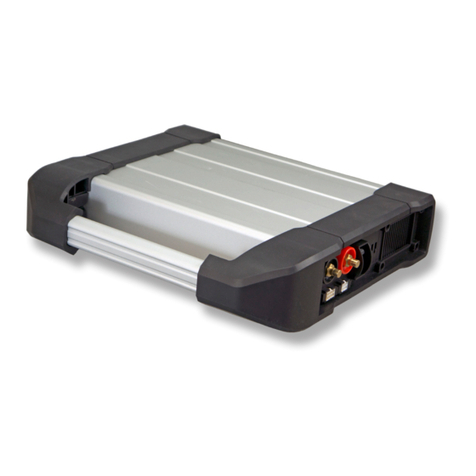
Midtronics
Midtronics MSP-070-5 user guide
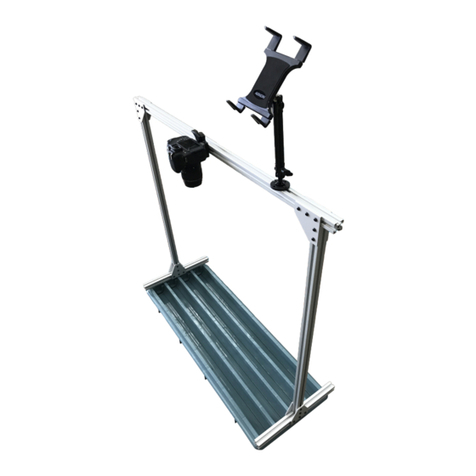
Dynamics
Dynamics SPSF user manual

Sennetech
Sennetech SCT-100-Pelco-Visca user manual

Sony
Sony IPT-DS1 - Party-shot Digital Camera Docking... Specifications
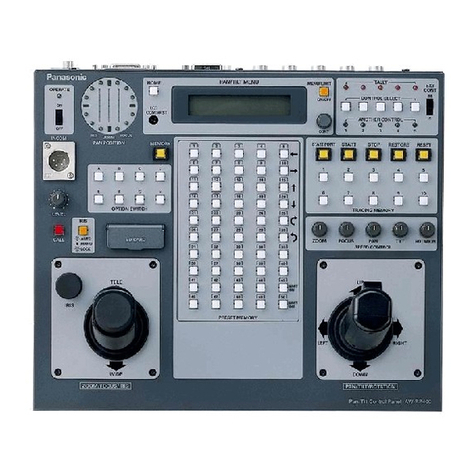
Panasonic
Panasonic AWRC400N - PAN/TITLT HEAD operating instructions
